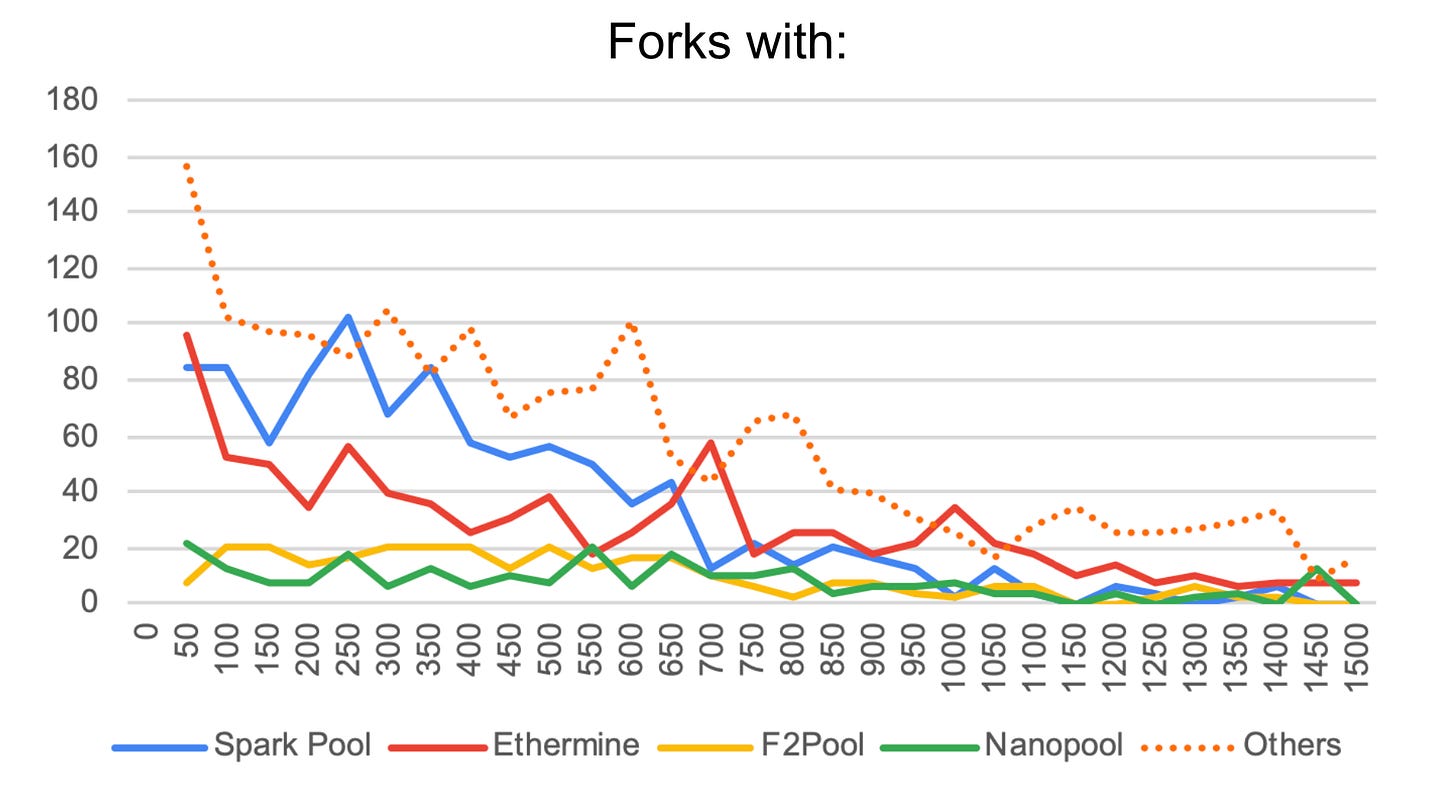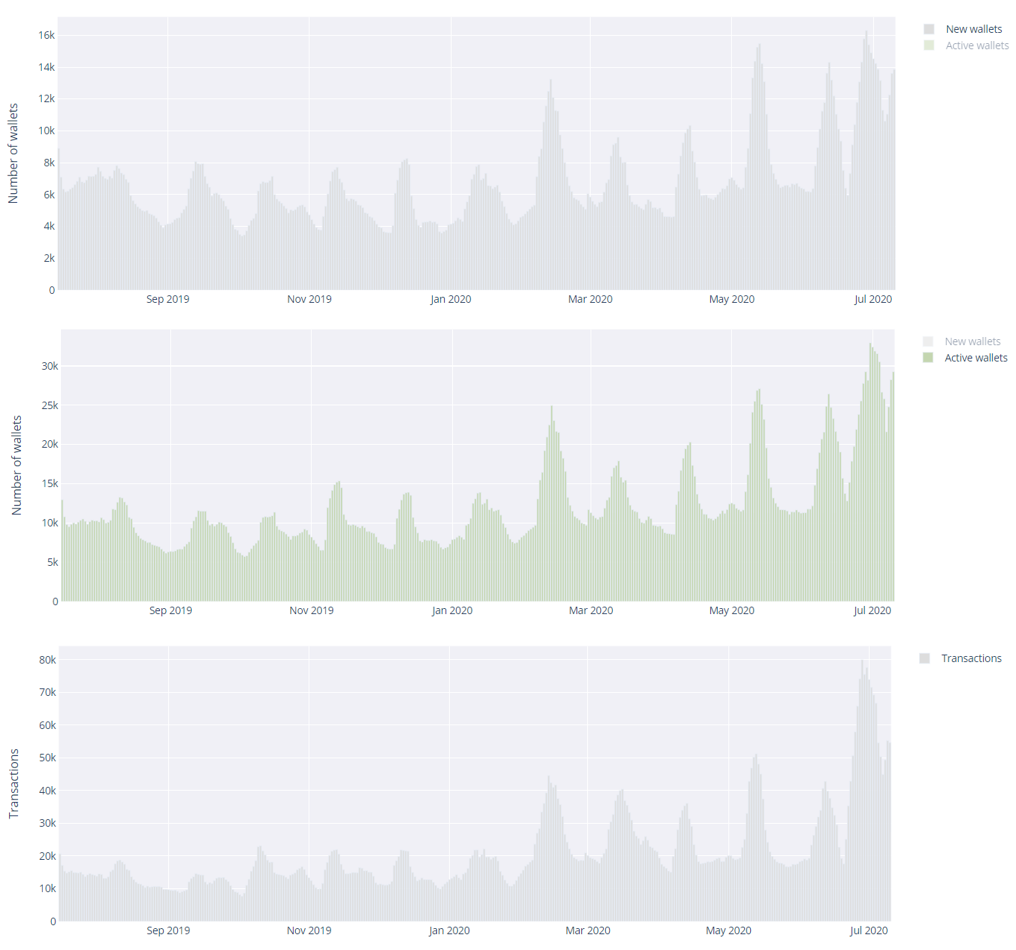Continued from Part 1.
When forks occur, we measure the delta between the two blocks. We break those forks into 50 ms segments, which indicates how long it takes for miners to hear of a new block. We can see that almost 20% of miners move to mine the next block within 100 ms (0.1 sec) after a new block is mined, and it takes about 0.6 sec for half of the miners to start mining the next block. Lastly, almost all (90%) of the hashpower is already working on the next block within 1.5 sec. This should quiet the fears of those concerned that increasing the gas limit will break Ethereum as we’re not seeing a significant difference before and after gas increase.

Lastly, we measured the fork rate for the four largest ETH pools and found that they do not account for most of the forks despite them controlling most of the hashpower. Rather, it’s the smaller poolers who are the slowest to move on the next block. We are working closely with smaller pools to provide better network connectivity.

④ Basic Attention Token
Contributor: Blaise Cavalli, co-founder and CEO at Nyctale
The growth rate of Basic Attention Token network has recently reached a local stability zone in terms of long-term investors involved. Around mid-June, there were +175k wallets with a holder behavior around BAT tokens. This figure has slightly decreased during the last month but is still up around 30% YTD.

The network continues to show periodical activity cycle around specific’s behaviors (mainly incoming investors and speculators), with peaks of activity that keep reaching new all-time highs. These patterns are likely linked with monthly on-chain payment for advertisers / advertisements.

In parallel of these cyclic patterns, the last month of activity shows some unusual on-chain activity, with a clear surge in terms of speculators followed by outgoing investors. It might represent a network reaction linked with the price increase around 0.30$ in late June, which may have triggered sell-off from some investors.
Editor’s note: the primary catalyst for this surge was high “Yield Farming” rates on Compound.

New and active wallets have followed the last month activity surge with more than 15k weekly new wallets and more than 30k active ones observed in late June. As mentioned by Brave’s team on our last contribution, it is important to understand that these figures don’t represent all the activity within the BAT ecosystem, of which some part is happening off-chain and / or on a dedicated side chain.

Looking at transaction’s value, there is a clear trend break in late June with a massive increase in terms of average and total value associated with on-chain transactions.
During the months of April and May, the amount of token transferred on a weekly basis was mainly between 100M and 300M, with an average transaction’s value between 7k and 10k tokens.
During the months of June and in early July, the total value exchanged has moved on the upside with 4 to 8B tokens transferred per week (representing a $1-2B weekly on-chain volume at current price), involving transactions with an average value somewhere between 60 and 120k ($15-30k)
It represents a multiplicative factor of 25 in terms of token exchanged, and 10 for the average transaction’s value. But these figures remain hard to correctly interpret without having more context from the BAT team.

⑤ Chainlink
Contributor: ChainLinkGod
If you have been following the crypto space lately, you would have likely by now noticed the meteoric risk in the price of LINK, now placing it in the top ten cryptocurrencies, and a general increase of discussions surrounding its merit. As such, I want to focus on the on-chain data surrounding the LINK token itself to generate some context as to why this greater shift has recently occured. Since launch, Chainlink Price Reference Feeds have grown to over 30+ oracle networks sponsored and supported by 24 DeFi projects on the Ethereum mainnet.
Additionally, with over 200+ integrations in the pipeline, including 60 blockchains, adoption seems to have driven an increase in the on-chain activity of the LINK token on the Ethereum network as shown below. Below is the active address count of wallets each day that hold more than 10 LINK tokens. A year ago this resided around 10,000 addresses, but has since more tripled to 35,000 active addresses. 10,000 of these addresses have actually appeared in the last few weeks alone.

Source: Nyctale
However, it is not just address count that has been growing, but transaction count has steadily been on the rise as well, growing from 30k daily transactions a year ago to now over 90k daily transactions. This growth is occurring from an increase in the amount of speculation, but more importantly it has also been driven by growth of Chainlink oracle networks as they require nodes to be paid in the LINK token.
An interesting outlier is in March 2020, during which Black Thursday occurred where crypto market prices crashed by 50%. LINK transaction count spiked from 80k to over 140k and afterwards later leveled off at 60k transactions a day for the rest of 2020. This spike can largely be attributed to the increased network activity as most Chainlink oracle networks operate on a deviation based update schedule.

Source: Nyctale
Lastly the growth in the number of total cumulative wallets shows that the majority of the growth is from addresses holding less than 1,000 LINK. From only 20k addresses holding under 1,000 tokens a year ago to now over 75k addresses, it is likely many new users are holding LINK, rather than just existing addresses, increasing the distribution of the supply.
As DeFi continues to grow in total value locked from $2B to beyond, the infrastructure powering DeFi such as decentralized oracles are along for the ride. Shout out to Blaise Cavalli of Nyctale for providing these awesome charts.

Source: Nyctale
Editor’s note: Unfortunately, this is ChainLinkGod’s last post for the newsletter. If you would like to replace him as Chainlink’s regular contributor, please reply to this email directly.

